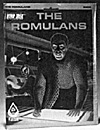
Designed by David E Tepool, Guy W. McLimore, Jr., and Greg K. Poehlein
FASA Corporation P.O. Box 6930, Chicago, IL 69680
Released: October, 1984
Catalog No. 2005
Price: $10.00
Complexity: Intermediate
Solitaire Suitability: Low
*****
In the almost 20 years since the start of the TV series, the universe of Star Trek has been expanded through cartoons, books, magazines and the musings of fans-and most recently by supplements and additions to FASA Corporation's Star Trek: The RolePlaying Game (ST:RPG). Among the best of these gaming expansions to the Trek mythos is The Romulans, FASA Corp.'s definitive look at Star Trek's other villains.
The Romulans is packaged in FASA Corp.'s recent folder-style set, as opposed to the boxed (and thus more expensive) treatment of The Klingons. The cover depicts a bridge scene aboard a Romulan warship, apparently in combat. Though not outstanding, it is quite adequate in conveying the proper impression of the supplement's contents. Inside the lightweight folder are two 8 1/2 X 11 inch books, formatted like those in the ST:RPG second-edition set. One 32-page book, entitled The Romulans: Starfleet Intelligence Manual, is set up as though it were designed for briefing Federation officers on what Starfleet knows, or has deduced, about their elusive opponents across the Neutral Zone. The second book, The Romulan Way: Game Operations Manual, at 48 pages, gives specific game information for Gamemasters (GMs) who wish to run Romulan campaigns or players who wish to generate Romulan characters to run in a game.
The intelligence manual gives a good overview of Romulan culture, including a glossary of Romulan terms; notes on the Romulan language, with pronunciation guides, individual names, etc.; and general data on the Star Empire and the Romulan people themselves-history, interstellar interactions, the home systems, naval organization and the like. Most of the information therein is described as having come from a series of books, documents and notes found on an abandoned Romulan base and collectively published as 7-be Eridam Papers. This approach lends an extra air of authenticity to the supplement, which also gives it value even to nongaming Star Trek fans who can't get enough information about their favorite science fiction series. Sections on Romulan equipment, a short starship recognition file, and sample Romulan characters round out this book.
The game operations manual expands upon much of the data in the intelligence book, filling in the details that would be unavailable to the Federation, but that native Romulan characters--and the GM--would be expected to know as a matter of course. Thus where the map of the Romulan Empire in the first book is fairly and any Star Trek aficionado who desires additional valid, Paramountapproved information on Star Trek's other villains. sketchy, listing boundaries as the Federation knows or believes them to be, the operations manual maps the true extents of the Star Empire (or "Road to the Stars" in the Romulan, or Rom'lnz, language). Comprehensive information on Romulan religion and the various stages of Romulan life, their government, game data on Romulus and Remus (Rom'lasz and Rav's in the Rom'lesta tongue) and other important worlds of the Star Empire, plus detailed Romulan military organizational charts increase our knowledge of this vulcanoid race. The sections on judging the Romulan Way and Creating and Training Romulan Characters integrate the supplement firmly into the parent game system for role-playing action.
Both FASA Corp. and the designers of The Romulans deserve praise for the care they put into bringing this supplement to the Star Trek gaming community. The books are well-organized, and specific items of information are easy to find from book to book. There is some duplication of information, but with the Federation- view/Romulanview dichotomy of the two books, this is unavoidable, and usually more helpful than not. I did find the placement of character generation as the last item of the operations manual a bit odd, but it certainly is not a problem.
The only real omission I noted was a lack of exact rules on how to use the cloaking device when role-playing starship combat: The skill description did not tell when a skill saving roll would be necessary, nor what would happen if it was missed, making it necessary for the Gamemaster (GM) to wing it on this point.
The Romulans rates high on Trek authenticity, too. Nowhere did I find anything in the book that didn't mesh perfectly with the established Trek mythos of either the original series and movies or previous "official" gaming releases. A new Plasma Weapon Damage chart replaces those in previous game supplements.
I unhesitantly recommend The Romulans to all ST:RPG GMs, players who want to run Romulan characters.
More Role Game Reviews
- Game Review: Conan Role-Playing Game
Game Review: Vapors Don't Shoot Back Paranoia Scenario
Game Review: Sandman - Map of Halaal
Game Review: The Romulans: A Star Trek: The Role-Playing Game Supplement
Game Review: Earthshaker! A Dungeons and Dragons Companion Game Adventure
Game Review: Rangers of the North: The Kingdom of Arthedain
Game Review: Fluffy Quest: A Generic Adventure for Fantasy Role-Playing Systems
Back to Table of Contents -- Game News #12
To Game News List of Issues
To MagWeb Master Magazine List
© Copyright 1986 by Dana Lombardy.
This article appears in MagWeb (Magazine Web) on the Internet World Wide Web.
Other military history articles and gaming articles are available at http://www.magweb.com